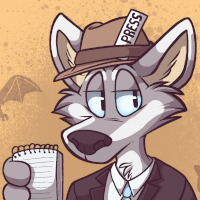Over Time, by Kyell Gold – book review by Fred Patten.
by Patch O'Furr
Submitted by Fred Patten, Furry’s favorite historian and reviewer.
Over Time, by Kyell Gold. Illustrated by Rukis and Kenket.
St. Paul, MN, Sofawolf Press, January 2016, hardcover $39.95 (432 pages), trade paperback $19.95 ([5] + 376 [+ 2] pages), Kindle $9.99.
 Over Time is a romance novel intended for an adult audience only and contains some explicit sexual scenes of a primarily Male/Male nature. It is not for sale to persons under the age of 18. (publisher’s advisory)
Over Time is a romance novel intended for an adult audience only and contains some explicit sexual scenes of a primarily Male/Male nature. It is not for sale to persons under the age of 18. (publisher’s advisory)
Over Time is the final volume in this series; Out of Position Book 5. It’s hard to write a meaningful review of this Book 5 alone without covering all the background. If you’re familiar with the first four novels – Out of Position (January 2009), Isolation Play (January 2011), Divisions (January 2013), and Uncovered (July 2014) – you’ve probably already gotten this Book 5. If you’re not, you’ll do better to read all five in the proper order. They’re all five worth it.
They’re also all very homoerotic, with explicit gay m/m sex scenes. They are about two young men (who happen to be a tiger and a red fox) falling in love and going through considerable lovemaking with all the erect penises and the sticky bodily fluids, as they go through life. Kyell Gold is a prize-winning, top-quality author, and these five novels are so well-written that you will be caught up in the lives of Devlin Miski (the tiger) and Wiley “Lee” Farrel (the fox), even if you don’t care for the gay sex scenes. Or even if you don’t care for football – there are also many scenes of explicit extended football action.
The five novels are narrated in the first person by Dev and Lee, in mostly alternating chapters. In the first book, Out of Position, Dev and Lee are adolescent seniors at Forester University. Dev is a cornerback on the university’s football team, and Lee is a gay activist. Dev has a one-night stand with what seems to be a sexy vixen who turns out to be Lee in drag. Dev realizes that his sexual orientation is gay and that he is in love with the male Lee, while Lee realizes that his practical joke on a football jock has led him to a real romance. After carrying on their romance in secrecy, the novel ends with Dev publicly “coming out of the closet”; the first football player to do so. (Out of Position was published several years before the first admittedly gay football player in real life.)


 Soldiers of Ice, by David Cook. Map. (Forgotten Realms – The Harpers, Nº 7)
Soldiers of Ice, by David Cook. Map. (Forgotten Realms – The Harpers, Nº 7) La Saga d’Atlas & Axis, t.3, by Pau.
La Saga d’Atlas & Axis, t.3, by Pau. Dudley & Gilderoy: A Nonsense, by Algernon Blackwood.
Dudley & Gilderoy: A Nonsense, by Algernon Blackwood.
 Hunters Unlucky, by Abigail Hilton. Illustrated by Sarah Cloutier. Maps by Jeff McDowall.
Hunters Unlucky, by Abigail Hilton. Illustrated by Sarah Cloutier. Maps by Jeff McDowall.
 Shadow Walkers, by Russ Chenoweth.
Shadow Walkers, by Russ Chenoweth. The Bears’ Famous Invasion of Sicily, by Dino Buzzati. Translated by Frances Lobb. Illustrated by the author.
The Bears’ Famous Invasion of Sicily, by Dino Buzzati. Translated by Frances Lobb. Illustrated by the author.